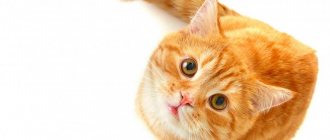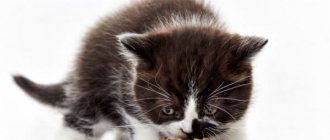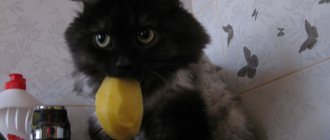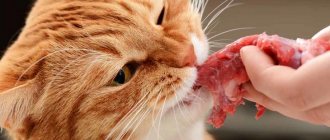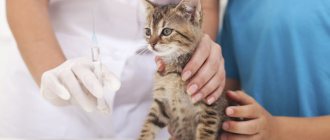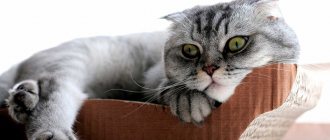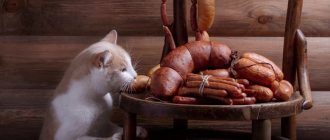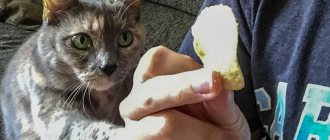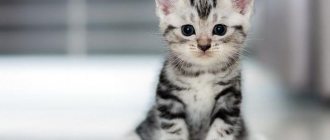When a new baby is brought into the house, a number of questions immediately arise: what to name him, where to arrange the toilet, what he will play with and where to sleep. But the first and most important question will always be - what to feed the kitten?
Kittens, aged 2 to 4 months, already need to have a complete diet. It should include not only proteins, fats and carbohydrates, but also vitamins and minerals. If you do not want to feed your pet balanced ready-made food, then you can develop a menu yourself.
Chicken has tender, nutritious meat that is easily digestible by the kitten. Poultry meat or minced meat made from it can become the basis of your pet’s diet. However, when feeding, you should take the necessary precautions to protect your pet from diseases.
You can prepare minced chicken for kittens with your own hands or buy ready-made. When making it yourself, you need to remember that the meat must first be frozen. This will prevent helminths from getting into the baby. It should also be taken into account that adding salt and spices to the minced meat is unacceptable. Likewise, when purchasing a finished product, you must carefully read the ingredients, and after purchasing, keep the minced meat in the freezer for at least a day.
For a kitten more than 4 months old, minced meat alone is not enough. It is necessary to add grains and vegetables to the diet. For feeding, you need to stir the food in equal proportions. It is also worth diversifying your pet’s diet and alternating minced chicken with meat or fish.
"EXPOCOT 2011" - PRESENTATION OF THE BURMAN BREED
Burmese cats are luxury, exclusivity, grace and charm!
Burmese cats are the embodiment of natural harmony, beauty and perfection! These cats are elegant, have a refined appearance, in which simplicity is adjacent to nobility.
The main feature of the European Burmese breed is its short, glossy, tight-fitting coat, silky to the touch. The coat of Burmese cats is smooth, shiny, reminiscent of satin, and has a palette of colors unique to this breed - brown (sable), chocolate (champagne), lilac (platinum), blue. The brightest and most eye-catching color of Burmese cats is brown, also known as sable. But touching the fur of a Burmese cat evokes even greater delight. It seems as if the most expensive silks of the East are enveloping your palm. Each hair, colored from the root to the very tip, fits tightly to the cat's body. The fur softly shines and shimmers with every movement of the animal. Touching this luxury, you forget all your affairs and problems, and you can no longer deny yourself the pleasure of holding this miracle in your hands.
The character of the Burmese cat is no less unique than its colors and it can be safely called its main advantage. European Burmese are very friendly and playful animals. These cats love the company of people very much, which is why, in terms of their attitude towards people, they are often compared to dogs. The well-known saying that a cat walks on its own has nothing to do with Burmese cats. This cat has a completely unique feature - a genetic taboo on human skin, therefore the Burmese cat is not capable of aggression towards humans and under no circumstances does it scratch or bite. The European Burmese is absolutely non-aggressive, patient in relationships with children, and easily learns the rules of behavior, thanks to its high intelligence. It is thanks to its character that the European Burmese is becoming more and more popular every day almost all over the world. European Burmese are all elegance, grace and tact. Her boundless love, tender and touching attitude towards people amazes and surprises.
I will be glad to introduce you to my animals, tell you about their achievements, show many wonderful photographs, share useful information, and maybe help you find a little loving friend.
The nursery is engaged in breeding only the breed of cats - EUROPEAN BURMA (Burmese).
I tried to find for you a lot of interesting and useful information about the Burmese breed:
- history of the Burmese breed
- Burmese breed standards
- Burmese pedigree database
- main differences between European and American Burmese cats
- family tree of the ancestors of the Burmese breed
- gallery of photos of kittens (European Burmese)
- film about Burmese apartments
- care, maintenance and feeding of kittens (European Burmese)
- articles about the Burmese breed
- stories of happy kitten owners (European Burmese)
- rules for selling kittens
- contract for the sale of kittens and much, much more!
°°°°°°°°°°°°°°°°°°°°°°°°°°°°°°°°°°°°°°°°°°°°°°°°°°°°°°°°°°°°°°°°°°°°°°°°°°°°°°°°
Natural cat food
Question: why do people associate natural feeding of cats with bowls of minced meat, and many beginners start their journey by looking for a more powerful meat grinder? Do cats really need to grind their food into mince?
Pieces or minced meat. Photo: Veronica Kozyreva
Cats should definitely not eat minced meat. Cats are equipped with the jaws and teeth of a strictly carnivorous animal, which can tear and gnaw its sometimes quite large prey.
The dental system is of a pronounced carnivorous type. The fangs are long and curved. The molars, a number of which are shortened, have sharp, cutting apices, which are especially powerful in carnassial teeth. An important role in eating meat is played by an extremely rough (like a grater) muscular tongue, covered with pointed, curved horny papillae. — G. A. Novikov
The last false-rooted tooth in the upper jaw and the first molar in the lower jaw in most predators are strongly protruding and have high and sharp cusps; these teeth are called carnivorous, and are used for gnawing bones, tendons, etc. — “Zoology”, Lukin E.I.
Don't believe it when they tell you that domestic cats are no longer predators. The domestic cat is endowed with all the morphological features of felines and is a typical representative of the family of the most specialized of all predatory animals and is fully adapted to obtaining animal food.
However, in many groups and communities dedicated to natural feeding of cats, including on some foreign websites, the association with meat minced through a meat grinder has become firmly entrenched. This is primarily due not to the fact that cats cannot chew themselves, but to the fact that most owners, before they realized the benefits of natural nutrition for their pets, had cats that ate canned pates, canned food of a uniform consistency with jelly and small dry food granules. For the owners themselves, starting with feeding minced meat is psychologically much easier, since the minced meat is more similar in consistency to what they fed their cats before. Large pieces with bones cause bewilderment and fear for many.
Therefore, on the one hand, owners are filled with fear that a cat that has been eating pate all its life may not be able to cope with a large piece, choking, getting hurt, etc. On the other hand, the cat itself may not know that the piece of meat offered to it is food, since, along with its mother’s milk, from the first days of its life it has absorbed the smell of the food that it ate and grew up on, and that is what it considers food, and not a piece of meat offered to her that she simply doesn’t know what to do with.
In this case, it is permissible to switch from feed to minced meat. Grind all parts of the diet on a large wire rack and mix it with your usual canned food, if you don’t eat without it. The consistency of the minced meat will be more familiar and understandable to the cat, she will be more likely to start eating it, and at the same time she will get used to the taste and smell of raw meat. Minced meat is also good because in the process of accustoming a cat to new ingredients, you can easily disguise the necessary components in it. If a cat doesn’t like something, but eats something with a hunter, then you can mix everything, then the cat won’t notice and won’t be able to choose, but will eat everything. Also, minced meat or small pieces are acceptable for toothless cats or for kittens up to 2 months left without a mother. After 2 months, kittens can already be offered large pieces. For a healthy cat with a full set of teeth, there is no point in minced meat and the cat needs to be fed as close to its natural environment as possible - large pieces that it can bite off and crush with its jaws before swallowing. For normal digestion, food is processed with saliva until a food coma is formed, treated with enzymes and antibacterial substances. Mechanical and chemical processing of food in the mouth is considered one of the stages of digestion and for humans it is of great importance since it is in the mouth that the first part of the hydrolysis of carbohydrates occurs. S-type salivary alpha-amylase, which is present in human saliva but absent in cat saliva, is responsible for this process. You can also notice that the cat hardly wets the food clump with saliva; sometimes it swallows prey only by slightly crushing the tissue with its teeth.
The cat chews large pieces with hard ones, using predatory teeth on one side or the other of the mouth. Such pieces are also necessary in nutrition because in the process of gnawing they remove plaque from the teeth and create pressure on the teeth, stimulate the gums, and create microconstipation that cleans the cat’s anal glands.
Cats that have eaten food and pates all their lives do not have sufficiently developed jaw muscles. These muscles need to be pumped up, that is, gnawing. The masseter (numbered in the picture is the chewing muscle) is pumped up exactly like this. If, instead of ready-made minced meat, on an empty stomach you first give a large piece of meat, or even better, a chicken neck or head, and only then, when the cat has chewed it up and gives up, give out the minced meat until completely saturated.Then the cat will relearn faster.
These muscles need to be pumped up, that is, gnawing. The masseter (numbered in the picture is the chewing muscle) is pumped up exactly like this. If, instead of ready-made minced meat, on an empty stomach you first give a large piece of meat, or even better, a chicken neck or head, and only then, when the cat has chewed it up and gives up, give out the minced meat until completely saturated.Then the cat will relearn faster.
The size of the piece is also critical; if the cat is able to swallow it immediately without tearing it or trying to chew, then the piece is too small. It is best to cut into pieces that are not large in cross section, but long enough so that the cat learns to bite off smaller pieces from them, which it can already swallow.
It would be worth noting that there are studies that show the effect of the degree of grinding of food on the health of the brain and nervous system.
The effects of chewing are not limited to the hippocampus; chewing increases the level of fos immunoreactivity in the right prefrontal cortex and decreases it in the central nucleus of the right amygdala. And increased prefrontal activity helps us think better and cope with stress. Chewing also has a positive effect on cerebral blood flow, and MRI studies also show that it affects the function of the cerebellum, which is associated with the control of rhythmic motor activity. Chewing also reduces the release of norepinephrine in the amygdala and reduces ACTH and cortisol levels. Soft crushed food (soft diet) leads to a decrease in working memory, a decrease in neurogenesis in the hippocampus, and increases the risk of neurodegenerative disorders. — Doctor Ph.D. Andrey Beloveshkin
Animals deprived of the ability to gnaw and chew quickly began to exhibit memory impairment and learning problems. For both dogs and cats, the therapeutic value of being able to chew on their food should not be underestimated. Large pieces and meat bones are important not only from a nutritional point of view, but also for the animal’s psyche.
Chewing is a stress coping strategy, and its protective role has been shown not only in mice, but also in primates and humans. With excess stress, bruxism is often observed - teeth grinding during sleep, which increases the risk of tooth decay and other problems. — Doctor Ph.D. Andrey Beloveshkin
There are also studies that prove that in various species of animals, grinding food not only does not increase the digestibility of food, but on the contrary, the nutritional value of food remains the same or decreases.
Unfortunately, there are no studies, and therefore no scientific articles, comparing the health of cats that were fed minced meat in comparison with the health of cats that were fed large pieces of food. But some owners note that switching to a kibble diet in some cats reduces the frequency of vomiting episodes, improves the passage of bezoars and reduces the formation of tartar.
What scientific publications can you find? There are articles on feeding farm animals that note an increase in nutritional value when grinding feed (for example, fattening pigs) and they are associated with improving the availability of starch (this is of little relevance for cats).
There are studies on dogs, pigs, and poultry.
These studies show that feeding finely ground food has in some cases resulted in gastric ulcers (in pigs) and gastric volvulus (in dogs) within a short time after the start of feeding ground food.
In general, if we return to the reasons, when the size of food particles changes, the speed of passage of the food bolus through the gastrointestinal tract changes.
Large pieces of raw meat remain in the stomach longer, and they are exposed to the aggressive action of gastric juices and digestive enzymes. When prepared for maximum effective absorption, chyme passes into the intestines, where further fermentation and absorption of nutrients occur.
Chopped and liquid food passes from the stomach to the intestines faster, but at the same time, food particles enter the intestines “not prepared” for absorption, minced meat passes through “transit”.
As we can see, high speed is more of a minus than a plus.
Interestingly, if dogs are given a choice, they will prefer large pieces to small ones.
I would like to make special points that when preparing minced meat, taurine is lost and the risk of bacterial contamination of meat mixtures increases.
A whole piece of meat from a healthy animal is sterile inside. Bacteria begin to multiply on the surface of the piece of meat. Therefore, the larger the surface area, the more bacteria we have. From this point of view, minced meat is the most losing option: this is the maximum surface area to volume for the development of bacteria. Minced meat is stored much worse than a piece of meat.
Add to the bacteria the processes of surface oxidation due to contact with air and loss of intercellular fluid, and you get a much less attractive and complete product than it was before slicing (or grinding) and long-term storage.
Bacteria, by the way, are scary not only because they can harm the cat - bacteria also contribute to the destruction and not always the desired transformation of nutrients in meat during storage.
Let's summarize. Large pieces are naturally preferred by cats to ground mince. They are important for oral health, teeth cleaning, jaw muscle development, mental stimulation, proper digestion, etc.
Many owners have problems getting a cat that has been eating dry food and pates to immediately chew pieces and especially bones. There is also the problem that the cat does not eat everything, but chooses. In this case, twisting everything into one general mix or cutting some into pieces, and mixing some of the products into a sauce is a great way to get your cat to eat everything for the first time.
If you feed minced meat, do not stop at minced meat only and try to offer your cat her favorite foods in large pieces at least a couple of times a week so that she learns to chew and work with large-sized food.
Gradually increase the percentage of what you give in full. Alternate between feeding ground minced meat and large pieces. Give cats chicken necks, heads and other whole foods at least several feedings a week.
But in any case, I would like to note that even minced fresh meat with bones and organs is 1000 times better and healthier than any dry food or canned pate.
If you still have questions, you can contact us for a paid on-line consultation. To do this, write to us by email
Authors: Yulia Brovko, Veronika Kozyreva
The cat shows off a perfect white fang. Photo: Veronica Kozyreva
Sources:
Small size of food particles and age as risk factors for gastric dilatation of the volvulus in great danes. Theyse LF1, van de Brom WE, van Sluijs FJ.
Effect of diet particle size and feeding of H2-receptor antagonists on gastric ulcers in swine. Hedde RD, Lindsey TO, Parish RC, Daniels HD, Morgenthien EA, Lewis HB.
Small dogs prefer large kibble in palatability tests BY TIM WALL ON APRIL 27, 2018
Chewing Gum: Cognitive Performance, Mood, Well-Being, and Associated Physiology Biomed Res Int. 2015; 2015: 654806. Published online 2015
Influence of chewing and clenching on salivary cortisol levels as an indicator of stress. J Prosthodont. 2007 Mar-Apr; 16(2):129-35.
Adv Exp Med Biol. 2016;876:343-349. doi: 10.1007/978-1-4939-3023-4_43. Relationships Between Gum-Chewing and Stress.
Biomed Res Int. 2015;2015:876409. doi: 10.1155/2015/876409. Epub 2015 May 18. Mastication as a Stress-Coping Behavior.
